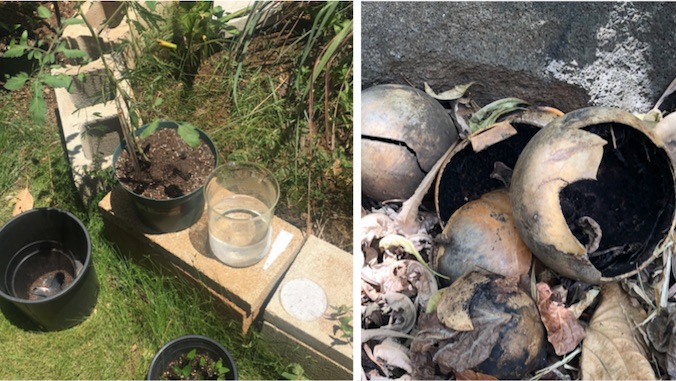
The highest number of potential mosquito breeding sites on campus are located in the student residential areas of the University of Hawaiʻi at Mānoa, according to research out of the Thompson School of Social Work & Public Health. The study, published in the Hawaiʻi Journal of Health & Social Welfare (PDF), advised practical strategies to reduce mosquito breeding.
Mosquitoes that live in Hawaiʻi, including Aedes aegypti and Aedes albopictus, can lay their eggs in any small object containing water. Mosquitoes can carry many pathogens, including the virus that causes dengue fever.
Strategies that could be used in residential areas to minimize mosquitoes include reducing litter and increasing awareness of the types of containers that are potential mosquito breeding sites, according to Pua Lani Yang, who led the study as an undergraduate student with the Office of Public Health Studies.
“Awareness campaigns about mosquito-borne diseases should be targeted towards students living on campus,” Yang said. “These campaigns should emphasize proactive approaches to reduce mosquito-breeding sites.”
Human activities play a role
For the study, Yang categorized all land on the UH Mānoa campus into designations, such as courtyards, streetscapes, civic spaces and residential spaces. Each area was then surveyed by walking heel to toe in a systematic pattern over the area, until the designated area was completely assessed.
Results showed that in residential areas, plastic cups, soda cans and other rubbish provide mosquitos with breeding sites. Kukui nut husks, bromeliads and planters were common breeding sites in courtyard areas. In civic spaces, tree root depressions offered places for mosquito breeding.
“Greater collaboration between the UH Mānoa landscaping and maintenance division and academic departments could help with surveillance of campus areas and strengthen pest-management plans,” Yang said. But the number of discarded food and beverage containers found during the survey suggests that human activities also play a large role in the number of breeding sites on campus. Yang said increasing the number of trash receptacles may help.
“Human encroachment into natural areas has influenced the emergence of mosquito-borne diseases around the world,” said Denise Nelson-Hurwitz, assistant professor of public health and a co-author of the study. “We all need to do our part to reduce litter and keep our community healthy.”
Public Health Professor Alan Katz also co-authored the study with Yang and Nelson-Hurwitz.
This research is an example of UH Mānoa’s goal of Excellence in Research: Advancing the Research and Creative Work Enterprise (PDF), one of four goals identified in the 2015–25 Strategic Plan (PDF), updated in December 2020.

